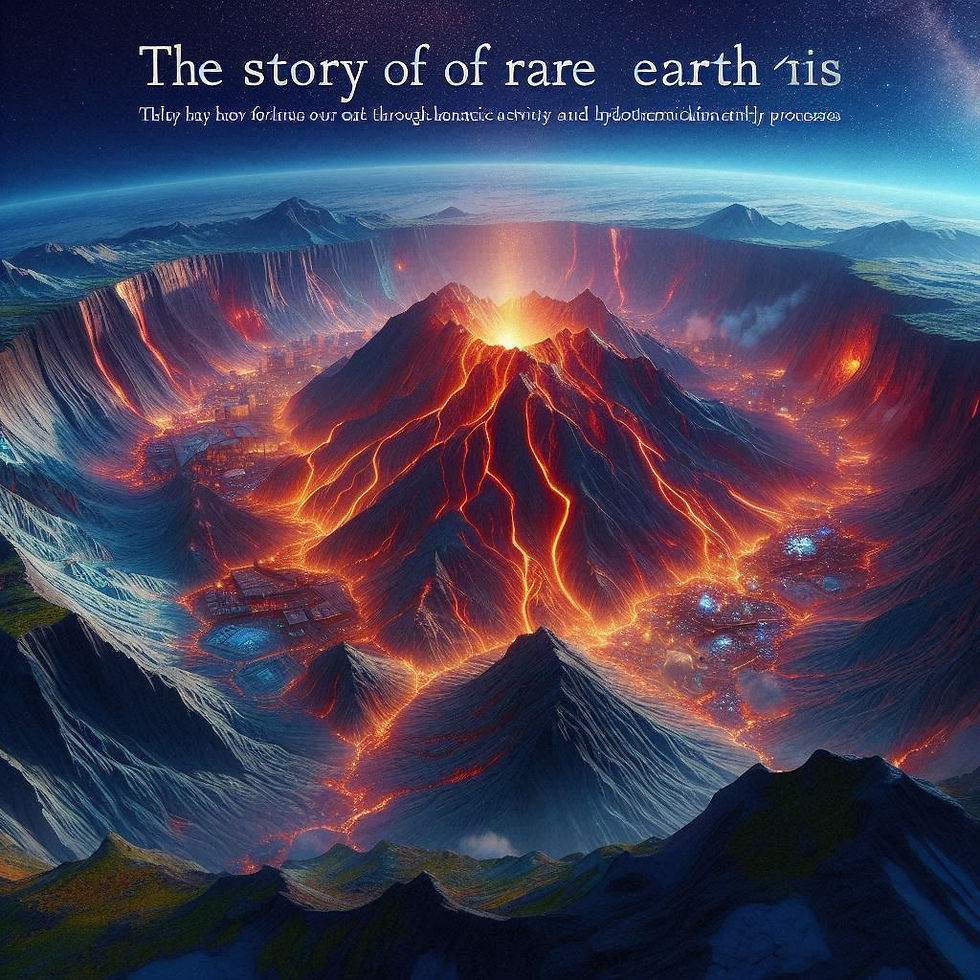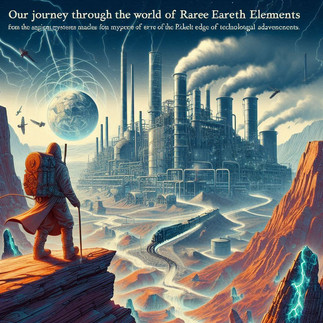Unearthing Rare Earths: A Journey Through Time and Technological Transformation
- Franco Arteseros
- Jul 22
- 4 min read
Imagine standing on the rugged, windswept expanse of the Pickett Wire Badlands, a place where the horizon stretches endlessly, and the ground holds secrets from ages long past. Each step echoes the history beneath your feet, where ancient elements wait to be discovered. These elements have the potential to power the future of our technology. As the wind whistles through the canyons, one might wonder: what mysteries lie below, and how will they shape our world?

What Are Rare Earths?

At the heart of modern technology are rare earth elements (REEs), a group of 17 metallic elements essential to various high-tech applications, from smartphones to electric vehicles. Key examples include:
Lanthanum: Vital for camera lenses and certain types of batteries.
Neodymium: Used in powerful magnets found in wind turbines and headphones.
Europium: Crucial for red phosphors in LED lights and television screens.

Though described as "rare," these elements are relatively abundant in the Earth's crust. For instance, the average concentration of neodymium in the crust is about 38 parts per million. However, they rarely occur in concentrated, economically viable deposits. This unique challenge underscores the importance of REEs in today's fast-evolving technological landscape.
Origins & Geologic History

The story of rare earths begins deep within the Earth’s crust, where they have formed over millions of years through volcanic activity and hydrothermal processes. For example, in regions like southern Colorado, ancient geological activity has produced deposits that are only now being explored for their rich potential. In fact, updated geological surveys estimate that Colorado alone may contain up to 1.5 million tons of rare earth oxides waiting to be tapped.
The Pickett Wire Badlands, with its dramatic landscapes, tells a tale of fire, water, and nature's transformative forces that shaped the minerals we depend on today.
Evolution Through Human History

The uses of rare earths have changed throughout history. In ancient times, societies used these elements to create colorful glass and metal alloys. For example, the Egyptians developed vibrant pigments with rare earth compounds for their dyes, showcasing an early appreciation of these elements.

However, it wasn’t until the latter half of the 20th century that REEs gained prominence in industrial applications. The introduction of color cathode ray tube (CRT) televisions in the 1950s marked a significant leap in technology. During the 1980s and 1990s, innovations such as smartphones, hard drives, wind turbines, and electric vehicles became increasingly reliant on rare earths.
Global events also influenced the rare earth narrative, especially during the Cold War when countries raced to secure resources. Today, ongoing concerns about supply chains bring renewed attention to the rare earth industry, with nations striving to fortify their access to these vital materials.

Rare Earths in Colorado

In Colorado, geological surveys have identified several deposits of REEs, particularly in the areas surrounding the Pickett Wire Canyonlands. These underexplored regions offer promising opportunities as erosion has exposed mineral beds that were once hidden.

The Pickett Wire area, known for its stark beauty, is a focal point for local enthusiasts and eco-conscious innovators. Many believe that this rugged landscape could become essential for clean technology and renewable energy. In 2022, an initiative was launched aimed at responsibly uncovering these elements, highlighting the intersection of adventure, science, and sustainable exploration.
The Cultural Significance of Rare Earths

While technological applications often dominate the conversation, the cultural significance of rare earths should not be overlooked. Various artifacts throughout history, infused with these elements, depict a deeper story of human creativity. Ancient dye colors and the strength of alloys in tools represent the strong bond communities had with nature.

Today, as we shift toward sustainable practices and eco-friendly innovations, rare earths expand beyond their functionality in gadgets. Their presence embodies a historical connection between ancient wisdom and contemporary technology. Understanding and preserving the ecosystems that house these elements becomes a crucial cultural mission.
Challenges in Extraction and Sustainability

While rare earth elements hold promise for future technologies, the extraction process poses significant environmental and ethical challenges. Mining these resources can lead to soil and water contamination, habitat destruction, and elevated greenhouse gas emissions.

For example, traditional mining methods have resulted in toxic waste that can leach into nearby water systems. To combat this, sustainable mining practices are imperative. Companies are investing in cleaner extraction methods, recycling processes, and alternative technologies that reduce the environmental impact. Increased community participation in discussions about responsible mining is noticeable, advocating for methods that do not compromise local ecosystems.
The Future of Rare Earths
Looking ahead, the role of rare earth elements in shaping future technologies is undeniable. As the world embraces renewable energy, the need for REEs in solar panels, batteries, and electric vehicles will only grow. According to recent estimates, global demand for neodymium and dysprosium is projected to rise by over 300% by 2030. Innovations in technology and a commitment to sustainability may allow us to source REEs locally, promoting green energy solutions that honor both humanity and nature.

Acknowledging the Connection
Our journey through the world of rare earth elements has taken us from the ancient mysteries of the Pickett Wire Badlands to the cutting edge of technological advancements. As we stand on the threshold of a sustainable future, we discover that the potential hidden beneath our feet is not just about technology. It also resonates deeply within our cultural and ecological consciousness.
The exploration continues — in the stunning terrains of Colorado and in our understanding of Earth’s resources. Embracing the mysteries of rare earths while nurturing the environment that holds them is a collective responsibility. Together, we can forge a path that harmonizes innovation with the wisdom of our past.
Franco Arteseros...




















Comments